| enter keyword to search: |
|
Images db
|
|
|
Articles db
|
|
|
|
|
|
|
|
|
The Varanasi name means between the rivers Varana and Asi, but it is also called in a number of other ways: Kashi (Kasi) the ĹCity of Lightĺ, intersection of the divive light (kÓsh) that destroys the darkness of ignorance, but also Avimuktaka, one of the names of Brahman the saviour, or AnandakÓnana (the greatest delight to God), Rudravasa, the place where Shiva (Rudra) resides and yet MahÓsmÓsana, "the Great Cremation ground". While Varanasi name refers to the urban settlement itself Kasi name is the sacred realm encircled by the outermost pilgrimage circuit Pancakrosiyatra.
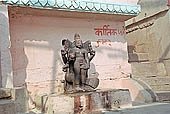
|
Ghats of Varanasi
|
Benares is the permanent abode of Shiva worshipped here as Vishveshvara (Visweswara) or VishvanÓtha, Lord of the Universe. Every place of the city is linked with one of his legends, or his sixtyfour incarnations (avatÓra) or to one of his onethousand and eight names, Lord of the religious hymns and of the sacrifices, the divine healer, shining like the sun, the one that brings prosperity to mankind and to the animals, the benignant, the one that frees from sins, the omniscient with the third eye (Triambaka). He is Mahadeva the Great God Maheshvara (the Great Lord), MahÓkala (the mighty time that restlessly destroyes everything), the MahÓ-yogin, PanchÓnana (with five heads representimg the four directions and the zenith). And yet Shiva is the creator but also in the same time the destroyer, he is Bhairava, the terribile, and Bh¨teshvara, Lord of the spirits that dwell the cremation grounds where he is seen as the Tandava (the dancer the dance of distruction and the creation). Shiva is usually represented with in his hairs, interwoven like a Yogin, the crescent moon and the Ganga Waters. His garlang is strung of skulls, because he is the lord of the deads, and his harms are twisted with poisonous snakes. The Trish¨la is his weapon, representing the triple aspect of creation (BrahmÓ), sustenance (Vishnu) and destruction (Shiva) of the world, and the power over the divine, earthly and under world. The sound of his Damaru, the hourglass shaped drum, represents the eternal cosmic play of creation and dissolution.
Shivalingam |
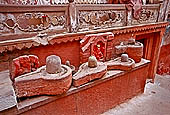
|
Several temples and shrines adorn Benares, virtually every block of houses has a shrine, lingams, the shapeless form of Shiva, counts by thousands, so as Nandi the bull vehicle and doorkeeper of its temples. Often atop the Lingam there is a cobra -Naag- Naga. One Jyotir-lingam (lingam of light) is worshipped in VishvanÓtha temple, here brahmins and pilgrims continuously perform the bathing ceremony abhisheka with Ganges sacred waters. Everywhere in the city it is possible to see smaller lingam, and in all shiva temple temples the lingam is always kept wet with Gange water falling day and night throughout a pot. In addition to the lingam, Shiva is also encountered in the form of weird dressed worshippers that, with the trishul in their hands, walk along the ghats singing hymns.
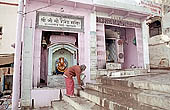
|
Lord Ganesh
|
Oftern we see some divinities, mainly Ganesh and Hanuman, represented with an aniconic form (murti) by unworked "natural" stones these are usually stone blocks covered over with red cloth or painted in red with an orange mixture made of sindour, the red powder, mixed with ghee clarified butter
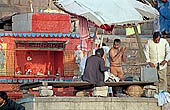
|
Mother Ganga
|
Banaras is a well-defined mandala with Visvesvara temple as its innermost sanctuary protected by successive shells. It is also one of the 51 Shakti Peethas the the places where the parts of the body of Sati felt on earth, in the tank known as Manikarnika well it is said that Sati earring dropped and that Shiva dug the tank out to recover it, filling it with his sweat. Even if one other legend says instead that Vishnu created the kund with his chakra, and filled it with perspiration and, when Shiva quivered with delighted, his earning fell into it.
Manikarnika Ghat |
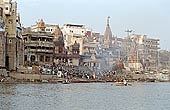
|
Benares is the holiest "tirthas", which literally means a "crossing" between the divine and the mortals. Lying at the centre of the five tirthas, Manikarnika Ghat the ghÓt of the deads, is the most sacred of all Ghats of the city. Here start the Panch-kosi yatra, the circuit, that some five hundred years ago became the outermost pilgrimage encircling a sacred territory ideally defined by a radius of pancakrosa or 17,6 km, with the the Lord of the Universe, Visvesvara, as its centre. After the vow at Jnanvapi and a purifying bath at Manikarnika Ghat - The pilgrimage start at Manikarnikesvara the first sanctuary on the Yatra hidden in a pit at the bottom of which (two floors below) there is the lingam, only the Brahmin may acceder at the lingam, from there the citcuit passes along 108 sacred places before returning to Manikarnika Ghat.
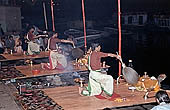
|
Varanasi ghats
|
Mahasmasaanam the great cremation ground of the entire universeů. Corpses are brought continuously in the smashan, the cremation ground, The Death Ritual starts with the body facing south, the abode of Yama the god of death. Then the feet, or sometimes the entire lower half of the body, is soaked into the river, this act prevents the vital principle, the prana, from leaving the body inauspiciously through one of its lower openings. Now the chief mourner usually the son performs a ritual circumambulation around the pyre before setting it on fire. As the pyre and corpse burn the head of the corpse is broken, at which time the soul leaves in the form of a preta to begin its postmortem journey. The son then bath to purify, but still remains untouchable for a period of 10 days during this time he goes every morning to a banyan tree close to the river, to offer Ganga water to the spirit. For the first twelve days after death the spirit is existing in the form of a 'preta', a wondering ghost, after which it is conceived as becoming an ancestor spirit a 'pitr', the spirit's journey to Yama's realm continues during the first year after death when he finally safely reaches, the 'pitr loka' the abode of the ancestors.
Varanasi ghats |
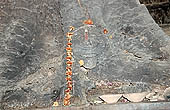
|
| |
|
|
 |
|
|



